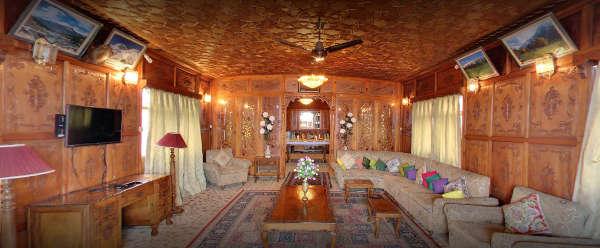Kashmir Handicrafts
Kashmiri handicrafts is world renowned and been appreciated since long time by the people all around the world. The exclusive items in exotic tastes are difficult to find elsewhere in the world. Kashmir produces some of its very own handicraft items for the people interested in Kashmiri Handicrafts and items. Though some duplicates are found in several places, which people sell and purchase by the name of Kashmiri Handicrafts. The intricacy and delicacy is difficult to find in others works.
Some must buy handicraft items one should buy are :
Carpet
Kashmiri carpets are very well known for their intricate and delicate piece of work. It may well be the single most extravagant purchase during your tour to Kashmir. Kashmiri carpets are world famous for two things - firstly, they are hand made and secondly, they are always knotted, never tufted. The yarn used normally is silk, wool or silk & wool. Woollen carpets always have a cotton base (Warp & Weft), The carpets are woven with certain motifs in vibrant colours. The finest of Kashmiri carpets are available at major showrooms. The amiable blend of colours makes the Kashmiri carpet a most loved possession.The colour and the design details differentiate it from any other carpet.
The knotting of the carpet is the most important aspect of carpet weaving. The knots of the carpets determines its durability and value, in addition to its design and pattern. The more knots per square inch, the greater becomes the value and durability of each carpet.
Papier Mache
There are three different grades of Papier Mache work, although if looked at a glance all looks quite same. Some are actually cardboard or wood. The idea is to provide a cheaper product for someone who wants the look of Papier Mache at cheaper price.
To make a Papier Mache, first paper is soaked in water till it breaks apart. It is then crushed, mixed with an adhesive solution, shaped over moulds, and allowed to dry and set before being painted and given the final touch.
Bright colours are used on the designs painted on objects of Papier Mache. They are distinct in artistry and colours. Gold is used on most objects, either as the only color, or as the highlight for any particular motif. Apart from the design, the type of gold used also determines the price of the object. The pure gold work which has an unrivalled luster, is far more expensive than bronze dust or gold poster paint. It also has much longer life and will never fade or tarnish. Varnish which is applied to the finished product, imparts a high gloss and smoothness which increases with every coat.
Basketry
Willows that grow in abundance in marshes and lakes in Kashmir are the raw materials to make aesthetically quaint items. The items generally made are shopping baskets, lampshades, tables and chairs, all generally inexpensive.
Walnut Wood
Kashmir is the only part of India where walnut trees grow. Its color, grains and inherent sheen are unique and outstanding, and the carving and fret work done on this wood is of supreme quality. There are two types of walnut trees – the fruit bearing species whose wood is so well- known, and one which bears no fruit.
The walnut wood is almost black, and the grain here is much more assured than the wood of the trunk which is lighter in color. The branches have the lightest color, being almost blonde, and have no evident grain. The intrinsic worth of the wood from each part of the tree differs- that from the root being the most expensive and the branches having the lowest price. Being one of the strongest varieties of wood, walnut has several varieties of carving. The walnut wood is generally used to make several types of handicraft items with unique Kashmiri artistry.
Copper and Silverware
Craftsmen are often seen engraving objects of household utility - samovars, bowls, plates and trays. Floral, stylized, geometric, leaf and sometimes calligraphic motifs are also engraved or embossed on copper and occasionally silver, to cover the entire surface with fine designs which are then oxidized, to stand out from the background. The work known as 'naqashi' and the weight of the object actuates the price of the object.


